Managing Change Assignment - Microsoft
VerifiedAdded on 2020/03/16
|17
|3710
|70
AI Summary
Contribute Materials
Your contribution can guide someone’s learning journey. Share your
documents today.
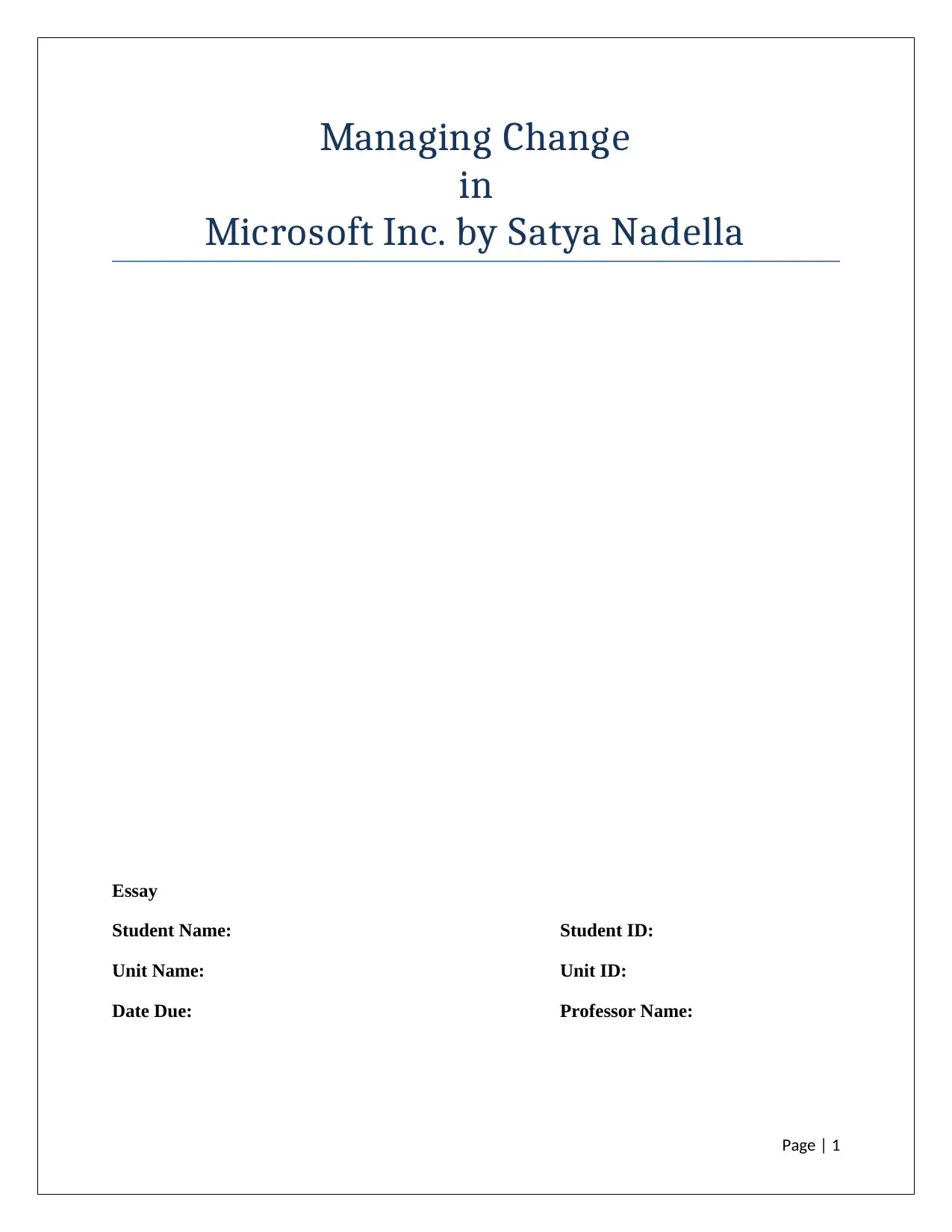
Managing Change
in
Microsoft Inc. by Satya Nadella
Essay
Student Name: Student ID:
Unit Name: Unit ID:
Date Due: Professor Name:
Page | 1
in
Microsoft Inc. by Satya Nadella
Essay
Student Name: Student ID:
Unit Name: Unit ID:
Date Due: Professor Name:
Page | 1
Secure Best Marks with AI Grader
Need help grading? Try our AI Grader for instant feedback on your assignments.
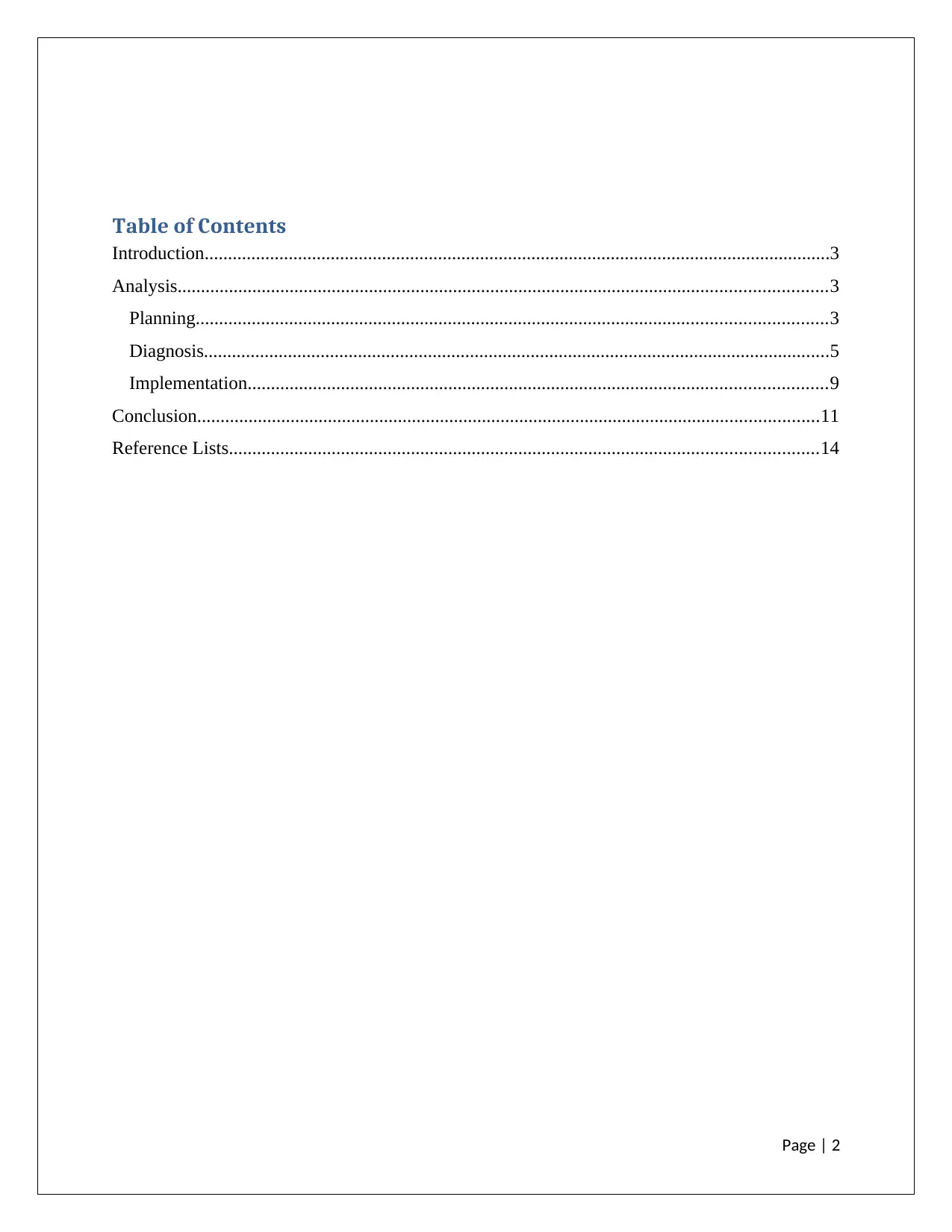
Table of Contents
Introduction......................................................................................................................................3
Analysis...........................................................................................................................................3
Planning.......................................................................................................................................3
Diagnosis......................................................................................................................................5
Implementation............................................................................................................................9
Conclusion.....................................................................................................................................11
Reference Lists..............................................................................................................................14
Page | 2
Introduction......................................................................................................................................3
Analysis...........................................................................................................................................3
Planning.......................................................................................................................................3
Diagnosis......................................................................................................................................5
Implementation............................................................................................................................9
Conclusion.....................................................................................................................................11
Reference Lists..............................................................................................................................14
Page | 2
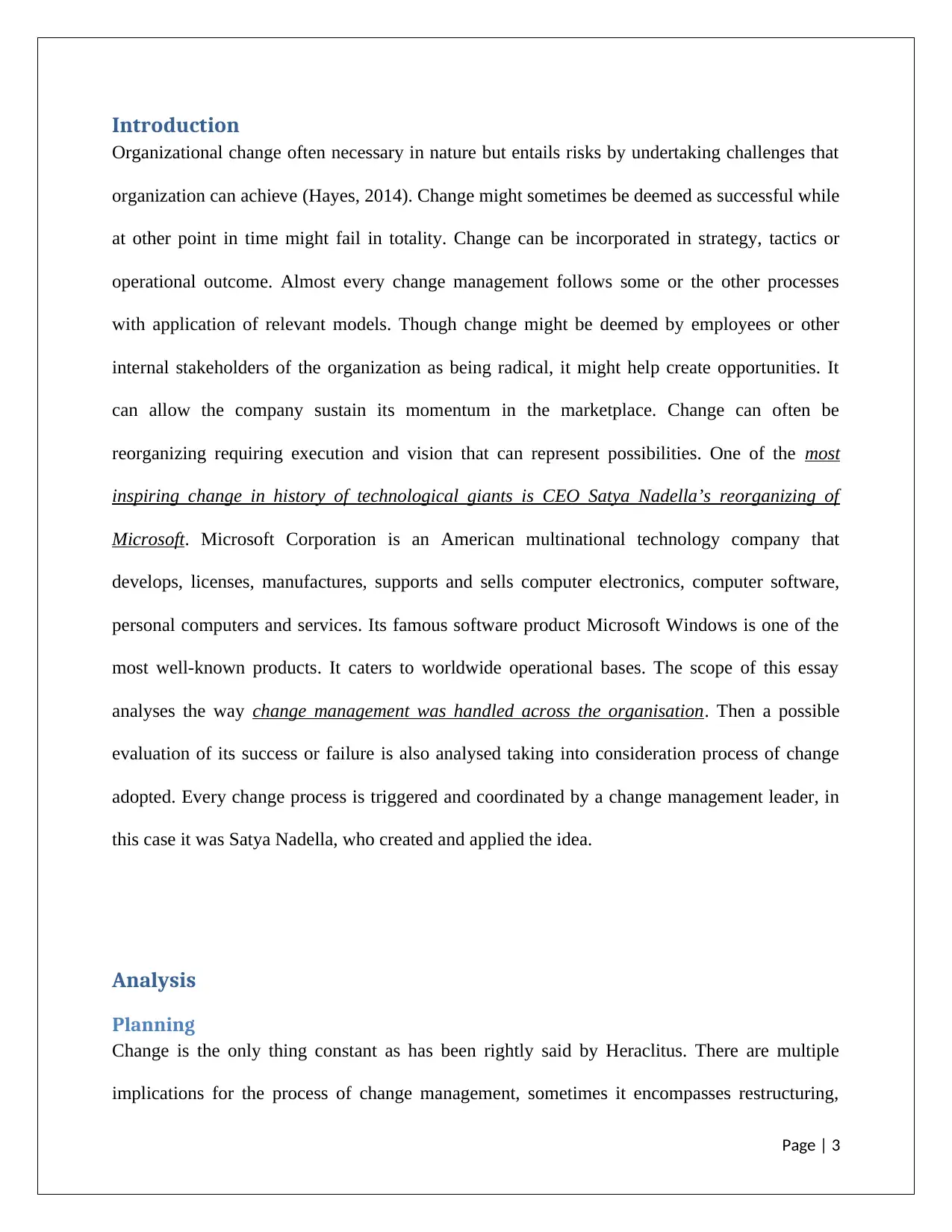
Introduction
Organizational change often necessary in nature but entails risks by undertaking challenges that
organization can achieve (Hayes, 2014). Change might sometimes be deemed as successful while
at other point in time might fail in totality. Change can be incorporated in strategy, tactics or
operational outcome. Almost every change management follows some or the other processes
with application of relevant models. Though change might be deemed by employees or other
internal stakeholders of the organization as being radical, it might help create opportunities. It
can allow the company sustain its momentum in the marketplace. Change can often be
reorganizing requiring execution and vision that can represent possibilities. One of the most
inspiring change in history of technological giants is CEO Satya Nadella’s reorganizing of
Microsoft. Microsoft Corporation is an American multinational technology company that
develops, licenses, manufactures, supports and sells computer electronics, computer software,
personal computers and services. Its famous software product Microsoft Windows is one of the
most well-known products. It caters to worldwide operational bases. The scope of this essay
analyses the way change management was handled across the organisation. Then a possible
evaluation of its success or failure is also analysed taking into consideration process of change
adopted. Every change process is triggered and coordinated by a change management leader, in
this case it was Satya Nadella, who created and applied the idea.
Analysis
Planning
Change is the only thing constant as has been rightly said by Heraclitus. There are multiple
implications for the process of change management, sometimes it encompasses restructuring,
Page | 3
Organizational change often necessary in nature but entails risks by undertaking challenges that
organization can achieve (Hayes, 2014). Change might sometimes be deemed as successful while
at other point in time might fail in totality. Change can be incorporated in strategy, tactics or
operational outcome. Almost every change management follows some or the other processes
with application of relevant models. Though change might be deemed by employees or other
internal stakeholders of the organization as being radical, it might help create opportunities. It
can allow the company sustain its momentum in the marketplace. Change can often be
reorganizing requiring execution and vision that can represent possibilities. One of the most
inspiring change in history of technological giants is CEO Satya Nadella’s reorganizing of
Microsoft. Microsoft Corporation is an American multinational technology company that
develops, licenses, manufactures, supports and sells computer electronics, computer software,
personal computers and services. Its famous software product Microsoft Windows is one of the
most well-known products. It caters to worldwide operational bases. The scope of this essay
analyses the way change management was handled across the organisation. Then a possible
evaluation of its success or failure is also analysed taking into consideration process of change
adopted. Every change process is triggered and coordinated by a change management leader, in
this case it was Satya Nadella, who created and applied the idea.
Analysis
Planning
Change is the only thing constant as has been rightly said by Heraclitus. There are multiple
implications for the process of change management, sometimes it encompasses restructuring,
Page | 3
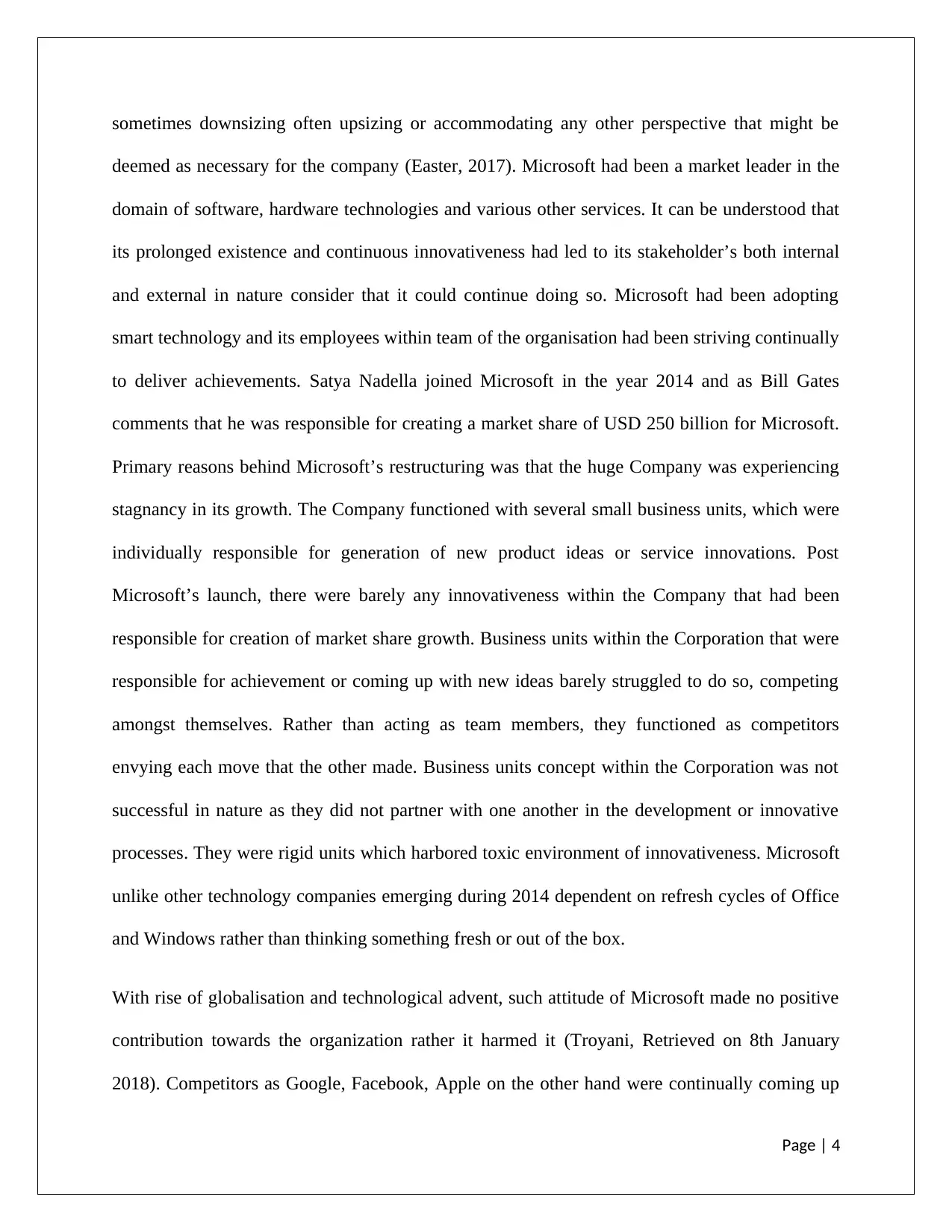
sometimes downsizing often upsizing or accommodating any other perspective that might be
deemed as necessary for the company (Easter, 2017). Microsoft had been a market leader in the
domain of software, hardware technologies and various other services. It can be understood that
its prolonged existence and continuous innovativeness had led to its stakeholder’s both internal
and external in nature consider that it could continue doing so. Microsoft had been adopting
smart technology and its employees within team of the organisation had been striving continually
to deliver achievements. Satya Nadella joined Microsoft in the year 2014 and as Bill Gates
comments that he was responsible for creating a market share of USD 250 billion for Microsoft.
Primary reasons behind Microsoft’s restructuring was that the huge Company was experiencing
stagnancy in its growth. The Company functioned with several small business units, which were
individually responsible for generation of new product ideas or service innovations. Post
Microsoft’s launch, there were barely any innovativeness within the Company that had been
responsible for creation of market share growth. Business units within the Corporation that were
responsible for achievement or coming up with new ideas barely struggled to do so, competing
amongst themselves. Rather than acting as team members, they functioned as competitors
envying each move that the other made. Business units concept within the Corporation was not
successful in nature as they did not partner with one another in the development or innovative
processes. They were rigid units which harbored toxic environment of innovativeness. Microsoft
unlike other technology companies emerging during 2014 dependent on refresh cycles of Office
and Windows rather than thinking something fresh or out of the box.
With rise of globalisation and technological advent, such attitude of Microsoft made no positive
contribution towards the organization rather it harmed it (Troyani, Retrieved on 8th January
2018). Competitors as Google, Facebook, Apple on the other hand were continually coming up
Page | 4
deemed as necessary for the company (Easter, 2017). Microsoft had been a market leader in the
domain of software, hardware technologies and various other services. It can be understood that
its prolonged existence and continuous innovativeness had led to its stakeholder’s both internal
and external in nature consider that it could continue doing so. Microsoft had been adopting
smart technology and its employees within team of the organisation had been striving continually
to deliver achievements. Satya Nadella joined Microsoft in the year 2014 and as Bill Gates
comments that he was responsible for creating a market share of USD 250 billion for Microsoft.
Primary reasons behind Microsoft’s restructuring was that the huge Company was experiencing
stagnancy in its growth. The Company functioned with several small business units, which were
individually responsible for generation of new product ideas or service innovations. Post
Microsoft’s launch, there were barely any innovativeness within the Company that had been
responsible for creation of market share growth. Business units within the Corporation that were
responsible for achievement or coming up with new ideas barely struggled to do so, competing
amongst themselves. Rather than acting as team members, they functioned as competitors
envying each move that the other made. Business units concept within the Corporation was not
successful in nature as they did not partner with one another in the development or innovative
processes. They were rigid units which harbored toxic environment of innovativeness. Microsoft
unlike other technology companies emerging during 2014 dependent on refresh cycles of Office
and Windows rather than thinking something fresh or out of the box.
With rise of globalisation and technological advent, such attitude of Microsoft made no positive
contribution towards the organization rather it harmed it (Troyani, Retrieved on 8th January
2018). Competitors as Google, Facebook, Apple on the other hand were continually coming up
Page | 4
Secure Best Marks with AI Grader
Need help grading? Try our AI Grader for instant feedback on your assignments.
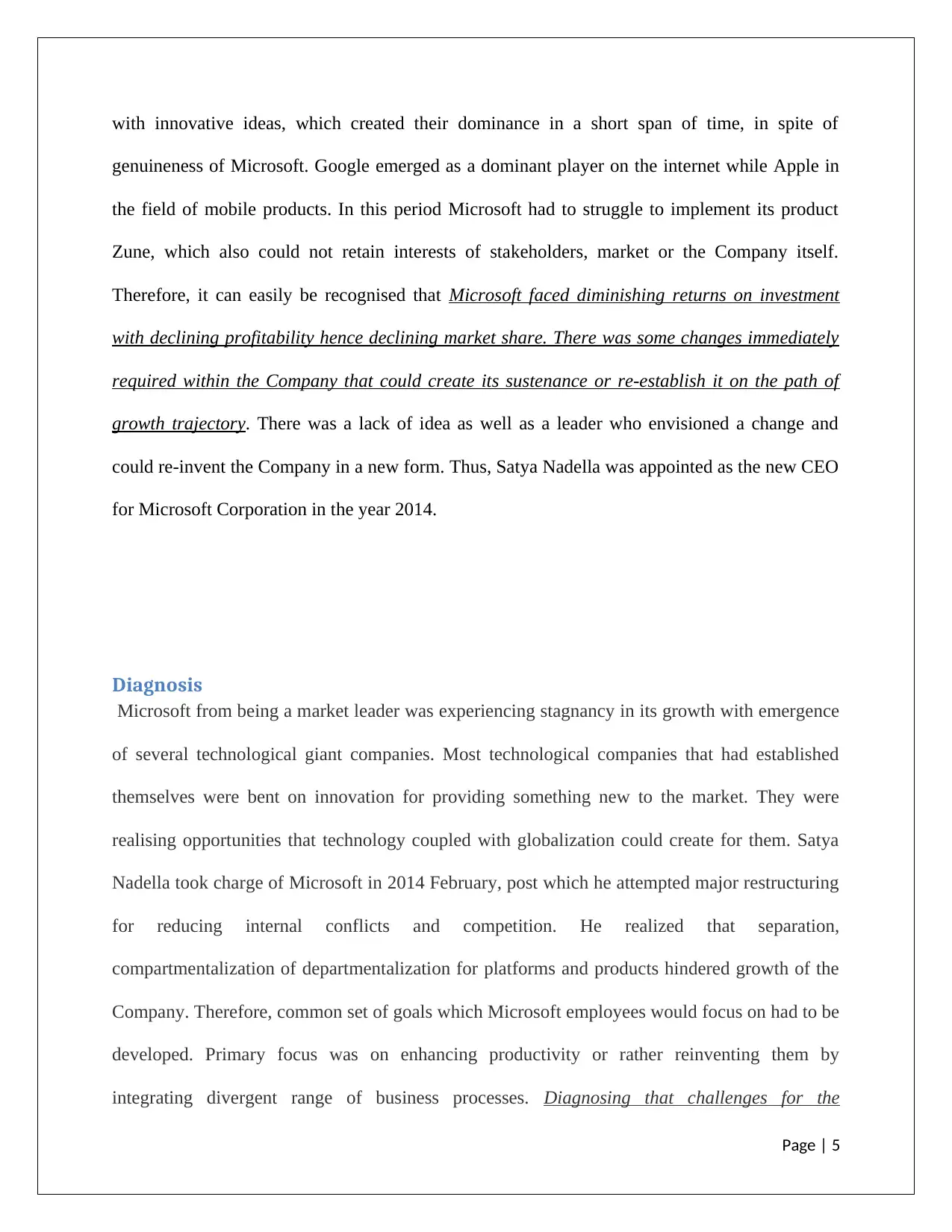
with innovative ideas, which created their dominance in a short span of time, in spite of
genuineness of Microsoft. Google emerged as a dominant player on the internet while Apple in
the field of mobile products. In this period Microsoft had to struggle to implement its product
Zune, which also could not retain interests of stakeholders, market or the Company itself.
Therefore, it can easily be recognised that Microsoft faced diminishing returns on investment
with declining profitability hence declining market share. There was some changes immediately
required within the Company that could create its sustenance or re-establish it on the path of
growth trajectory. There was a lack of idea as well as a leader who envisioned a change and
could re-invent the Company in a new form. Thus, Satya Nadella was appointed as the new CEO
for Microsoft Corporation in the year 2014.
Diagnosis
Microsoft from being a market leader was experiencing stagnancy in its growth with emergence
of several technological giant companies. Most technological companies that had established
themselves were bent on innovation for providing something new to the market. They were
realising opportunities that technology coupled with globalization could create for them. Satya
Nadella took charge of Microsoft in 2014 February, post which he attempted major restructuring
for reducing internal conflicts and competition. He realized that separation,
compartmentalization of departmentalization for platforms and products hindered growth of the
Company. Therefore, common set of goals which Microsoft employees would focus on had to be
developed. Primary focus was on enhancing productivity or rather reinventing them by
integrating divergent range of business processes. Diagnosing that challenges for the
Page | 5
genuineness of Microsoft. Google emerged as a dominant player on the internet while Apple in
the field of mobile products. In this period Microsoft had to struggle to implement its product
Zune, which also could not retain interests of stakeholders, market or the Company itself.
Therefore, it can easily be recognised that Microsoft faced diminishing returns on investment
with declining profitability hence declining market share. There was some changes immediately
required within the Company that could create its sustenance or re-establish it on the path of
growth trajectory. There was a lack of idea as well as a leader who envisioned a change and
could re-invent the Company in a new form. Thus, Satya Nadella was appointed as the new CEO
for Microsoft Corporation in the year 2014.
Diagnosis
Microsoft from being a market leader was experiencing stagnancy in its growth with emergence
of several technological giant companies. Most technological companies that had established
themselves were bent on innovation for providing something new to the market. They were
realising opportunities that technology coupled with globalization could create for them. Satya
Nadella took charge of Microsoft in 2014 February, post which he attempted major restructuring
for reducing internal conflicts and competition. He realized that separation,
compartmentalization of departmentalization for platforms and products hindered growth of the
Company. Therefore, common set of goals which Microsoft employees would focus on had to be
developed. Primary focus was on enhancing productivity or rather reinventing them by
integrating divergent range of business processes. Diagnosing that challenges for the
Page | 5
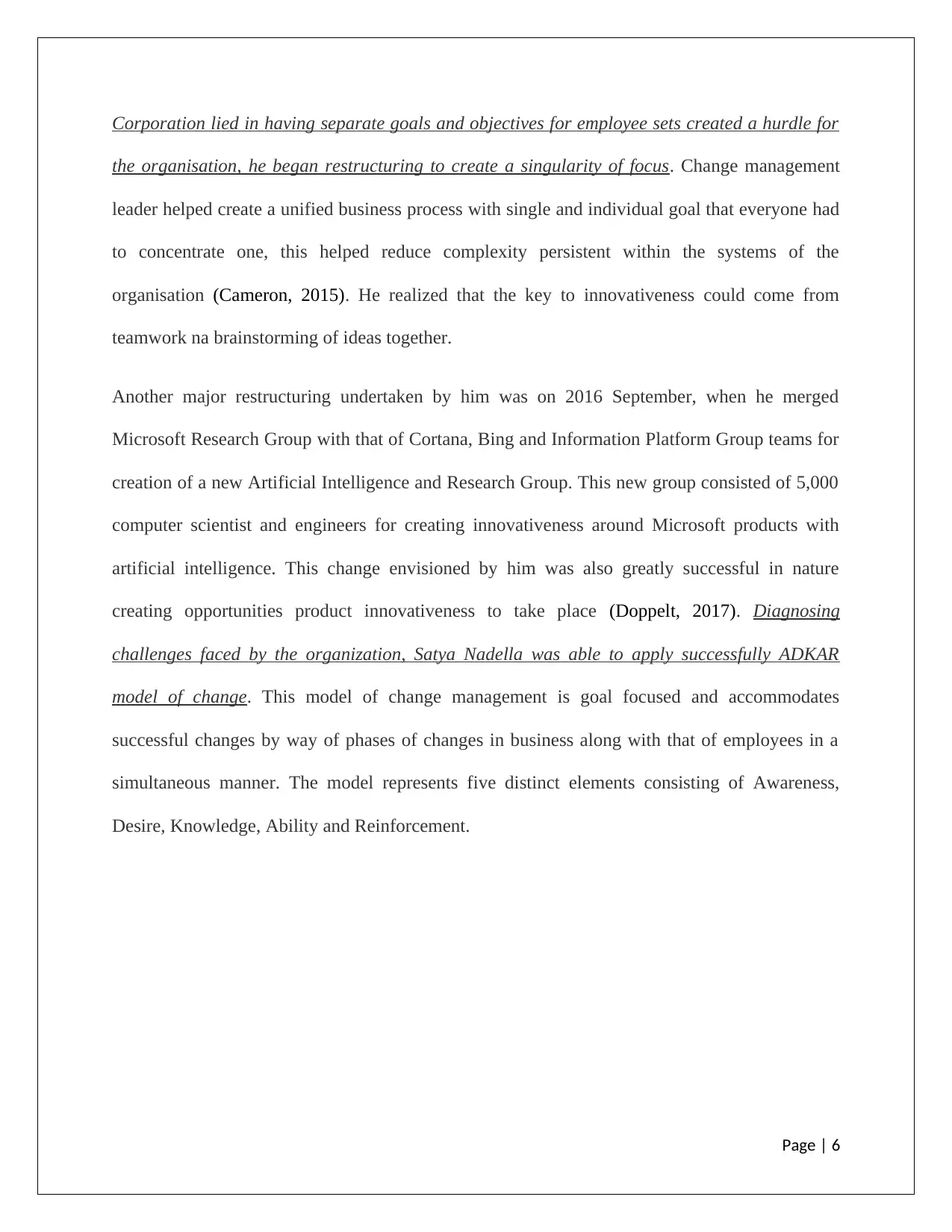
Corporation lied in having separate goals and objectives for employee sets created a hurdle for
the organisation, he began restructuring to create a singularity of focus. Change management
leader helped create a unified business process with single and individual goal that everyone had
to concentrate one, this helped reduce complexity persistent within the systems of the
organisation (Cameron, 2015). He realized that the key to innovativeness could come from
teamwork na brainstorming of ideas together.
Another major restructuring undertaken by him was on 2016 September, when he merged
Microsoft Research Group with that of Cortana, Bing and Information Platform Group teams for
creation of a new Artificial Intelligence and Research Group. This new group consisted of 5,000
computer scientist and engineers for creating innovativeness around Microsoft products with
artificial intelligence. This change envisioned by him was also greatly successful in nature
creating opportunities product innovativeness to take place (Doppelt, 2017). Diagnosing
challenges faced by the organization, Satya Nadella was able to apply successfully ADKAR
model of change. This model of change management is goal focused and accommodates
successful changes by way of phases of changes in business along with that of employees in a
simultaneous manner. The model represents five distinct elements consisting of Awareness,
Desire, Knowledge, Ability and Reinforcement.
Page | 6
the organisation, he began restructuring to create a singularity of focus. Change management
leader helped create a unified business process with single and individual goal that everyone had
to concentrate one, this helped reduce complexity persistent within the systems of the
organisation (Cameron, 2015). He realized that the key to innovativeness could come from
teamwork na brainstorming of ideas together.
Another major restructuring undertaken by him was on 2016 September, when he merged
Microsoft Research Group with that of Cortana, Bing and Information Platform Group teams for
creation of a new Artificial Intelligence and Research Group. This new group consisted of 5,000
computer scientist and engineers for creating innovativeness around Microsoft products with
artificial intelligence. This change envisioned by him was also greatly successful in nature
creating opportunities product innovativeness to take place (Doppelt, 2017). Diagnosing
challenges faced by the organization, Satya Nadella was able to apply successfully ADKAR
model of change. This model of change management is goal focused and accommodates
successful changes by way of phases of changes in business along with that of employees in a
simultaneous manner. The model represents five distinct elements consisting of Awareness,
Desire, Knowledge, Ability and Reinforcement.
Page | 6
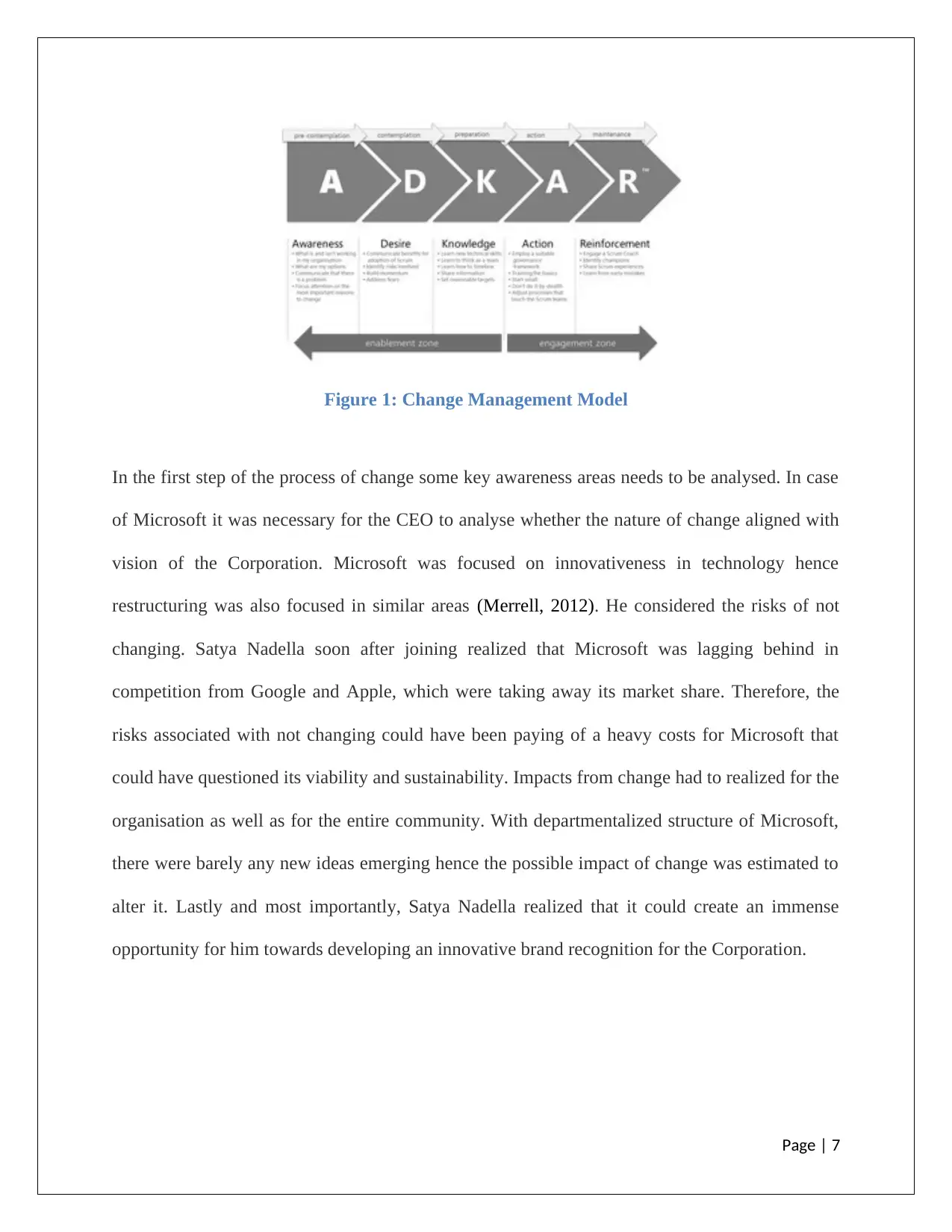
Figure 1: Change Management Model
In the first step of the process of change some key awareness areas needs to be analysed. In case
of Microsoft it was necessary for the CEO to analyse whether the nature of change aligned with
vision of the Corporation. Microsoft was focused on innovativeness in technology hence
restructuring was also focused in similar areas (Merrell, 2012). He considered the risks of not
changing. Satya Nadella soon after joining realized that Microsoft was lagging behind in
competition from Google and Apple, which were taking away its market share. Therefore, the
risks associated with not changing could have been paying of a heavy costs for Microsoft that
could have questioned its viability and sustainability. Impacts from change had to realized for the
organisation as well as for the entire community. With departmentalized structure of Microsoft,
there were barely any new ideas emerging hence the possible impact of change was estimated to
alter it. Lastly and most importantly, Satya Nadella realized that it could create an immense
opportunity for him towards developing an innovative brand recognition for the Corporation.
Page | 7
In the first step of the process of change some key awareness areas needs to be analysed. In case
of Microsoft it was necessary for the CEO to analyse whether the nature of change aligned with
vision of the Corporation. Microsoft was focused on innovativeness in technology hence
restructuring was also focused in similar areas (Merrell, 2012). He considered the risks of not
changing. Satya Nadella soon after joining realized that Microsoft was lagging behind in
competition from Google and Apple, which were taking away its market share. Therefore, the
risks associated with not changing could have been paying of a heavy costs for Microsoft that
could have questioned its viability and sustainability. Impacts from change had to realized for the
organisation as well as for the entire community. With departmentalized structure of Microsoft,
there were barely any new ideas emerging hence the possible impact of change was estimated to
alter it. Lastly and most importantly, Satya Nadella realized that it could create an immense
opportunity for him towards developing an innovative brand recognition for the Corporation.
Page | 7
Paraphrase This Document
Need a fresh take? Get an instant paraphrase of this document with our AI Paraphraser

Figure 2: ADKAR Model
Second aspect of the change processes requires motivation for participation and support towards
change management processes. Satya Nadella was effective in creation of motivation towards
change by overcoming critical resistance in the process from employees. He proved to be a great
change management leader capable of guiding and providing valuable inputs to employees for
the process of change. Thirdly, knowledge helps in the complexity of the change management
processes. Satya Nadella himself has a rich work experience and knowledge of technological
world. Further Microsoft employs some of the best brains in the world, forming teams with
computer scientists and engineers was a mere task at Microsoft (Galliers, 2014).
Employees possessed complex skill along with technological knowhow regarding their job
techniques for implementing the process of change. While the CEO came up with the idea to
Page | 8
Second aspect of the change processes requires motivation for participation and support towards
change management processes. Satya Nadella was effective in creation of motivation towards
change by overcoming critical resistance in the process from employees. He proved to be a great
change management leader capable of guiding and providing valuable inputs to employees for
the process of change. Thirdly, knowledge helps in the complexity of the change management
processes. Satya Nadella himself has a rich work experience and knowledge of technological
world. Further Microsoft employs some of the best brains in the world, forming teams with
computer scientists and engineers was a mere task at Microsoft (Galliers, 2014).
Employees possessed complex skill along with technological knowhow regarding their job
techniques for implementing the process of change. While the CEO came up with the idea to
Page | 8
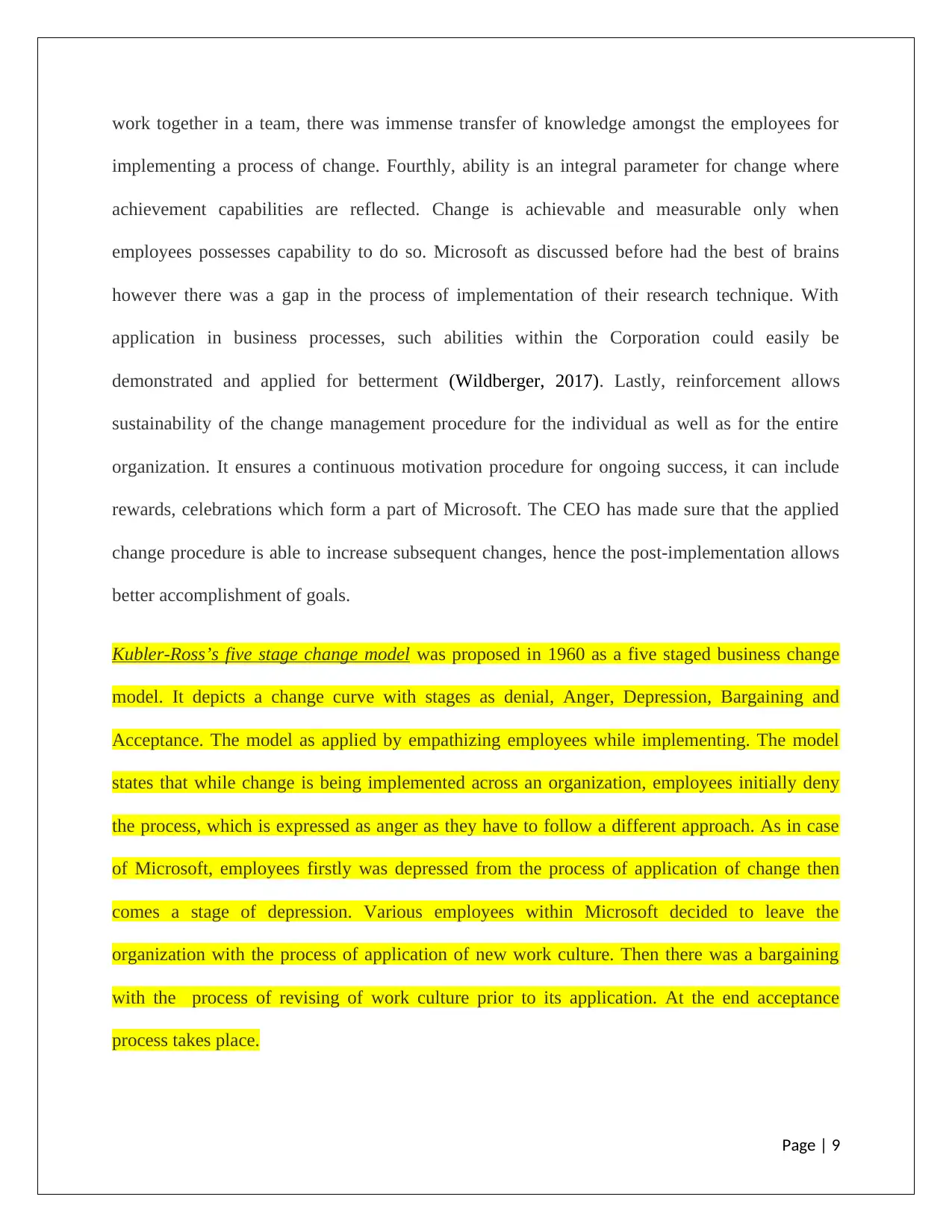
work together in a team, there was immense transfer of knowledge amongst the employees for
implementing a process of change. Fourthly, ability is an integral parameter for change where
achievement capabilities are reflected. Change is achievable and measurable only when
employees possesses capability to do so. Microsoft as discussed before had the best of brains
however there was a gap in the process of implementation of their research technique. With
application in business processes, such abilities within the Corporation could easily be
demonstrated and applied for betterment (Wildberger, 2017). Lastly, reinforcement allows
sustainability of the change management procedure for the individual as well as for the entire
organization. It ensures a continuous motivation procedure for ongoing success, it can include
rewards, celebrations which form a part of Microsoft. The CEO has made sure that the applied
change procedure is able to increase subsequent changes, hence the post-implementation allows
better accomplishment of goals.
Kubler-Ross’s five stage change model was proposed in 1960 as a five staged business change
model. It depicts a change curve with stages as denial, Anger, Depression, Bargaining and
Acceptance. The model as applied by empathizing employees while implementing. The model
states that while change is being implemented across an organization, employees initially deny
the process, which is expressed as anger as they have to follow a different approach. As in case
of Microsoft, employees firstly was depressed from the process of application of change then
comes a stage of depression. Various employees within Microsoft decided to leave the
organization with the process of application of new work culture. Then there was a bargaining
with the process of revising of work culture prior to its application. At the end acceptance
process takes place.
Page | 9
implementing a process of change. Fourthly, ability is an integral parameter for change where
achievement capabilities are reflected. Change is achievable and measurable only when
employees possesses capability to do so. Microsoft as discussed before had the best of brains
however there was a gap in the process of implementation of their research technique. With
application in business processes, such abilities within the Corporation could easily be
demonstrated and applied for betterment (Wildberger, 2017). Lastly, reinforcement allows
sustainability of the change management procedure for the individual as well as for the entire
organization. It ensures a continuous motivation procedure for ongoing success, it can include
rewards, celebrations which form a part of Microsoft. The CEO has made sure that the applied
change procedure is able to increase subsequent changes, hence the post-implementation allows
better accomplishment of goals.
Kubler-Ross’s five stage change model was proposed in 1960 as a five staged business change
model. It depicts a change curve with stages as denial, Anger, Depression, Bargaining and
Acceptance. The model as applied by empathizing employees while implementing. The model
states that while change is being implemented across an organization, employees initially deny
the process, which is expressed as anger as they have to follow a different approach. As in case
of Microsoft, employees firstly was depressed from the process of application of change then
comes a stage of depression. Various employees within Microsoft decided to leave the
organization with the process of application of new work culture. Then there was a bargaining
with the process of revising of work culture prior to its application. At the end acceptance
process takes place.
Page | 9

Figure 3: Kobler-Ross 5 Stage Model
The five stage model of change, once applied can have a host of disadvantages and advantages.
Deciding on a goal for the purpose will ensure a smoother process for transition. Allowing
appropriate time with transparency in process will help improvise condition for change within
employees.
Implementation
The change procedure implanted across Microsoft was immensely large as it encompassed re-
engineering of several procedure. The CEO was able to identify successfully business needs for
the organization for creation of awareness amongst employees (Klaus, 2014). In the process of
implementation of the change first comes identifying areas that needs to be changed. The
concept and design framework has to be assessed prior initiating the process of change
Page | 10
The five stage model of change, once applied can have a host of disadvantages and advantages.
Deciding on a goal for the purpose will ensure a smoother process for transition. Allowing
appropriate time with transparency in process will help improvise condition for change within
employees.
Implementation
The change procedure implanted across Microsoft was immensely large as it encompassed re-
engineering of several procedure. The CEO was able to identify successfully business needs for
the organization for creation of awareness amongst employees (Klaus, 2014). In the process of
implementation of the change first comes identifying areas that needs to be changed. The
concept and design framework has to be assessed prior initiating the process of change
Page | 10
Secure Best Marks with AI Grader
Need help grading? Try our AI Grader for instant feedback on your assignments.

management. Microsoft lacked the sense of common goal which was brought about by Satya
Nadella. He shared with the employees a new mission for the Corporation for achieving more for
everyone. Most integral part of the implementation of the change process was building a sense of
purpose within employees. He envisioned the core value embedded in achievement of the
mission, which was the culture. With creation of positive sense of purpose, he was capable of
heightening employee morale and engagement procedure. Procedure for change include bringing
together employees under the same umbrella or Corporation that could provide them a sense of
belongingness.
Earlier employees functioned merely as units catering to their individual work related goals.
There was absence of a leader, who could engage them in organization’s processes towards
achievement of something greater. Work culture was transformed by building a positive
organizational culture. Employee’s started to find greater motivation and engaged in work more.
There was low absenteeism rates with lower rates of turnover, they started feeling a part of the
organization. With limited scopes to work on and no areas to contribute beyond self-
responsibilities, employees experienced lowers levels of work satisfaction (Van der Voet, 2014).
The CEO created scope for employees to work on varied fields by opening up new dimensions to
work upon, employees felt more attachment towards the organization. Majority of technological
employees at the organization had best of graduating degrees with interests to research. With
new dimension of work culture, change implementation was highly successful. Satya Nadella
functioned as a transformational leader handling the process of change effectively that led to
successful implementation of the change procedure. He was able to successfully instill a new
work culture, a vision, mission and goal for the entire company and a sense of positive purpose.
His transformation within the organisation by restructuring of departments or products and
Page | 11
Nadella. He shared with the employees a new mission for the Corporation for achieving more for
everyone. Most integral part of the implementation of the change process was building a sense of
purpose within employees. He envisioned the core value embedded in achievement of the
mission, which was the culture. With creation of positive sense of purpose, he was capable of
heightening employee morale and engagement procedure. Procedure for change include bringing
together employees under the same umbrella or Corporation that could provide them a sense of
belongingness.
Earlier employees functioned merely as units catering to their individual work related goals.
There was absence of a leader, who could engage them in organization’s processes towards
achievement of something greater. Work culture was transformed by building a positive
organizational culture. Employee’s started to find greater motivation and engaged in work more.
There was low absenteeism rates with lower rates of turnover, they started feeling a part of the
organization. With limited scopes to work on and no areas to contribute beyond self-
responsibilities, employees experienced lowers levels of work satisfaction (Van der Voet, 2014).
The CEO created scope for employees to work on varied fields by opening up new dimensions to
work upon, employees felt more attachment towards the organization. Majority of technological
employees at the organization had best of graduating degrees with interests to research. With
new dimension of work culture, change implementation was highly successful. Satya Nadella
functioned as a transformational leader handling the process of change effectively that led to
successful implementation of the change procedure. He was able to successfully instill a new
work culture, a vision, mission and goal for the entire company and a sense of positive purpose.
His transformation within the organisation by restructuring of departments or products and
Page | 11
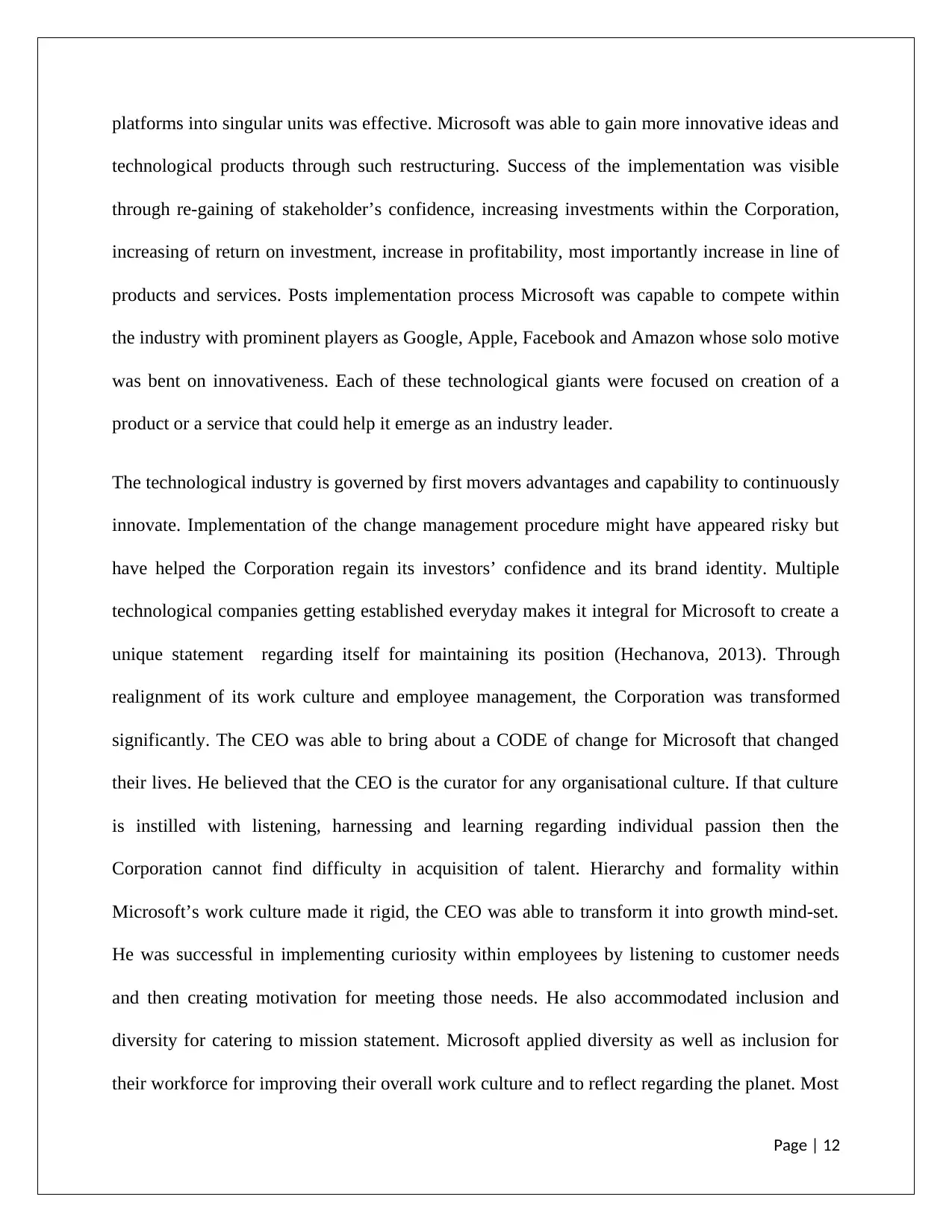
platforms into singular units was effective. Microsoft was able to gain more innovative ideas and
technological products through such restructuring. Success of the implementation was visible
through re-gaining of stakeholder’s confidence, increasing investments within the Corporation,
increasing of return on investment, increase in profitability, most importantly increase in line of
products and services. Posts implementation process Microsoft was capable to compete within
the industry with prominent players as Google, Apple, Facebook and Amazon whose solo motive
was bent on innovativeness. Each of these technological giants were focused on creation of a
product or a service that could help it emerge as an industry leader.
The technological industry is governed by first movers advantages and capability to continuously
innovate. Implementation of the change management procedure might have appeared risky but
have helped the Corporation regain its investors’ confidence and its brand identity. Multiple
technological companies getting established everyday makes it integral for Microsoft to create a
unique statement regarding itself for maintaining its position (Hechanova, 2013). Through
realignment of its work culture and employee management, the Corporation was transformed
significantly. The CEO was able to bring about a CODE of change for Microsoft that changed
their lives. He believed that the CEO is the curator for any organisational culture. If that culture
is instilled with listening, harnessing and learning regarding individual passion then the
Corporation cannot find difficulty in acquisition of talent. Hierarchy and formality within
Microsoft’s work culture made it rigid, the CEO was able to transform it into growth mind-set.
He was successful in implementing curiosity within employees by listening to customer needs
and then creating motivation for meeting those needs. He also accommodated inclusion and
diversity for catering to mission statement. Microsoft applied diversity as well as inclusion for
their workforce for improving their overall work culture and to reflect regarding the planet. Most
Page | 12
technological products through such restructuring. Success of the implementation was visible
through re-gaining of stakeholder’s confidence, increasing investments within the Corporation,
increasing of return on investment, increase in profitability, most importantly increase in line of
products and services. Posts implementation process Microsoft was capable to compete within
the industry with prominent players as Google, Apple, Facebook and Amazon whose solo motive
was bent on innovativeness. Each of these technological giants were focused on creation of a
product or a service that could help it emerge as an industry leader.
The technological industry is governed by first movers advantages and capability to continuously
innovate. Implementation of the change management procedure might have appeared risky but
have helped the Corporation regain its investors’ confidence and its brand identity. Multiple
technological companies getting established everyday makes it integral for Microsoft to create a
unique statement regarding itself for maintaining its position (Hechanova, 2013). Through
realignment of its work culture and employee management, the Corporation was transformed
significantly. The CEO was able to bring about a CODE of change for Microsoft that changed
their lives. He believed that the CEO is the curator for any organisational culture. If that culture
is instilled with listening, harnessing and learning regarding individual passion then the
Corporation cannot find difficulty in acquisition of talent. Hierarchy and formality within
Microsoft’s work culture made it rigid, the CEO was able to transform it into growth mind-set.
He was successful in implementing curiosity within employees by listening to customer needs
and then creating motivation for meeting those needs. He also accommodated inclusion and
diversity for catering to mission statement. Microsoft applied diversity as well as inclusion for
their workforce for improving their overall work culture and to reflect regarding the planet. Most
Page | 12

difficult part of the change management procedure is to convince individual stakeholders
regarding the importance of change, with appropriate application of knowledge the EO was able
to apply such as well. Impacts from a change might be positive or negative in nature but the
believe in the transformation process with its coordination with proper change management
leader helps attain success. Satya Nadella has written down his factors for success in the change
management process by transforming existing work cultures at Microsoft and he reflects the
process to be very Easter in nature.
Conclusion
Changes made by Satya Nadella was praised by Microsoft founder Bill Gates. Critics and
stakeholders of the Company accepted that Satya Nadella helped chart a whole new course for
Microsoft, by focusing on technological development. He has been regarded one of the most
successful leaders with Bill Gates and Steve Ballamer. Computing industry has become more
and more complex with companies as Google, Apple, Amazon, Facebook and other undertaking
several innovative endeavors. Consumer demands are also emerging from around the world with
latest and innovative techniques being adopted. Restructuring of Microsoft allowed teams to
work in a coordinated manner and develop something unique or innovative in nature. Partnering
of various departments with the organisation that previously worked in compartmentalized
bureaucratic manner allowed them freedom. Employees being able to discuss several ideas freely
was able to bring up more innovative trends in the business. The restructuring change was an
Page | 13
regarding the importance of change, with appropriate application of knowledge the EO was able
to apply such as well. Impacts from a change might be positive or negative in nature but the
believe in the transformation process with its coordination with proper change management
leader helps attain success. Satya Nadella has written down his factors for success in the change
management process by transforming existing work cultures at Microsoft and he reflects the
process to be very Easter in nature.
Conclusion
Changes made by Satya Nadella was praised by Microsoft founder Bill Gates. Critics and
stakeholders of the Company accepted that Satya Nadella helped chart a whole new course for
Microsoft, by focusing on technological development. He has been regarded one of the most
successful leaders with Bill Gates and Steve Ballamer. Computing industry has become more
and more complex with companies as Google, Apple, Amazon, Facebook and other undertaking
several innovative endeavors. Consumer demands are also emerging from around the world with
latest and innovative techniques being adopted. Restructuring of Microsoft allowed teams to
work in a coordinated manner and develop something unique or innovative in nature. Partnering
of various departments with the organisation that previously worked in compartmentalized
bureaucratic manner allowed them freedom. Employees being able to discuss several ideas freely
was able to bring up more innovative trends in the business. The restructuring change was an
Page | 13
Paraphrase This Document
Need a fresh take? Get an instant paraphrase of this document with our AI Paraphraser
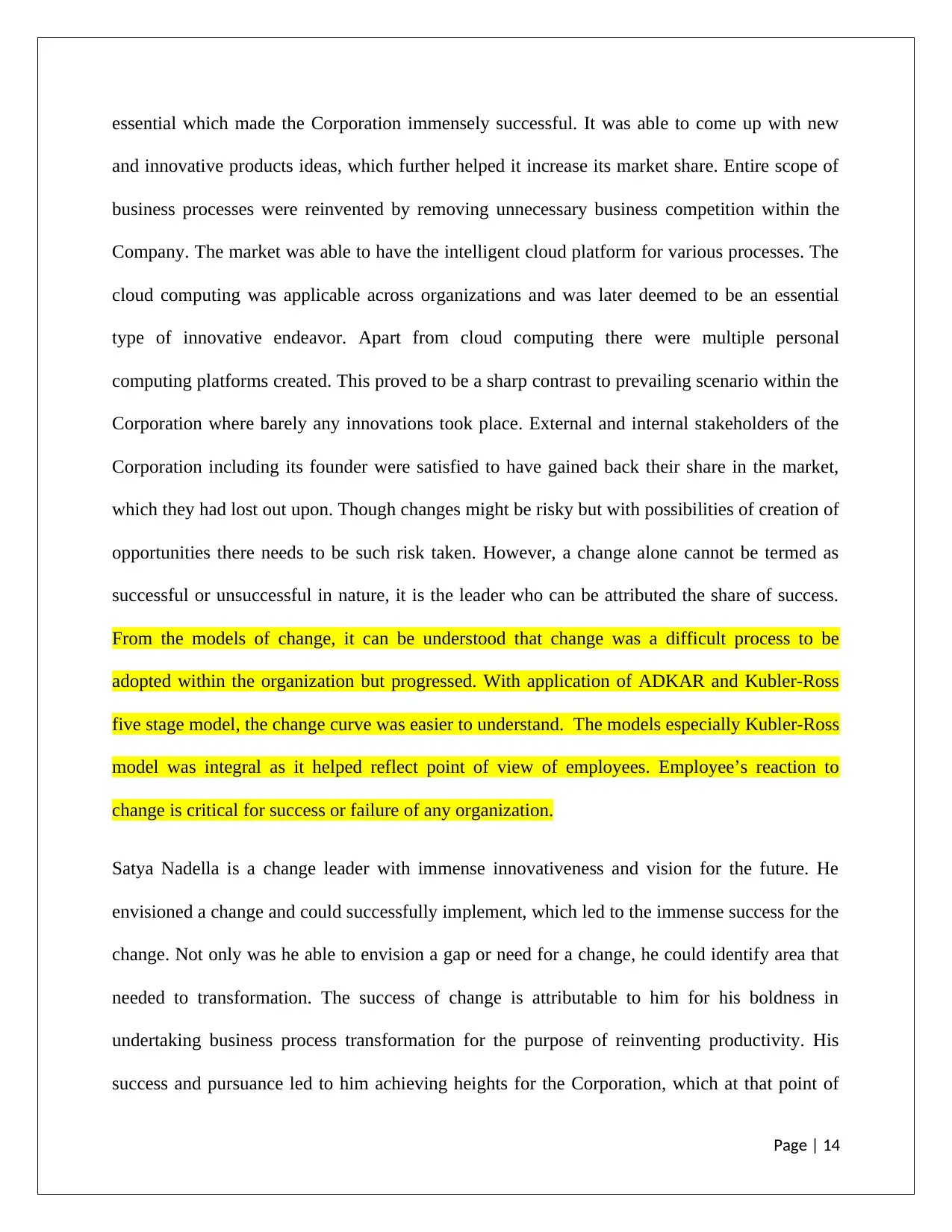
essential which made the Corporation immensely successful. It was able to come up with new
and innovative products ideas, which further helped it increase its market share. Entire scope of
business processes were reinvented by removing unnecessary business competition within the
Company. The market was able to have the intelligent cloud platform for various processes. The
cloud computing was applicable across organizations and was later deemed to be an essential
type of innovative endeavor. Apart from cloud computing there were multiple personal
computing platforms created. This proved to be a sharp contrast to prevailing scenario within the
Corporation where barely any innovations took place. External and internal stakeholders of the
Corporation including its founder were satisfied to have gained back their share in the market,
which they had lost out upon. Though changes might be risky but with possibilities of creation of
opportunities there needs to be such risk taken. However, a change alone cannot be termed as
successful or unsuccessful in nature, it is the leader who can be attributed the share of success.
From the models of change, it can be understood that change was a difficult process to be
adopted within the organization but progressed. With application of ADKAR and Kubler-Ross
five stage model, the change curve was easier to understand. The models especially Kubler-Ross
model was integral as it helped reflect point of view of employees. Employee’s reaction to
change is critical for success or failure of any organization.
Satya Nadella is a change leader with immense innovativeness and vision for the future. He
envisioned a change and could successfully implement, which led to the immense success for the
change. Not only was he able to envision a gap or need for a change, he could identify area that
needed to transformation. The success of change is attributable to him for his boldness in
undertaking business process transformation for the purpose of reinventing productivity. His
success and pursuance led to him achieving heights for the Corporation, which at that point of
Page | 14
and innovative products ideas, which further helped it increase its market share. Entire scope of
business processes were reinvented by removing unnecessary business competition within the
Company. The market was able to have the intelligent cloud platform for various processes. The
cloud computing was applicable across organizations and was later deemed to be an essential
type of innovative endeavor. Apart from cloud computing there were multiple personal
computing platforms created. This proved to be a sharp contrast to prevailing scenario within the
Corporation where barely any innovations took place. External and internal stakeholders of the
Corporation including its founder were satisfied to have gained back their share in the market,
which they had lost out upon. Though changes might be risky but with possibilities of creation of
opportunities there needs to be such risk taken. However, a change alone cannot be termed as
successful or unsuccessful in nature, it is the leader who can be attributed the share of success.
From the models of change, it can be understood that change was a difficult process to be
adopted within the organization but progressed. With application of ADKAR and Kubler-Ross
five stage model, the change curve was easier to understand. The models especially Kubler-Ross
model was integral as it helped reflect point of view of employees. Employee’s reaction to
change is critical for success or failure of any organization.
Satya Nadella is a change leader with immense innovativeness and vision for the future. He
envisioned a change and could successfully implement, which led to the immense success for the
change. Not only was he able to envision a gap or need for a change, he could identify area that
needed to transformation. The success of change is attributable to him for his boldness in
undertaking business process transformation for the purpose of reinventing productivity. His
success and pursuance led to him achieving heights for the Corporation, which at that point of
Page | 14
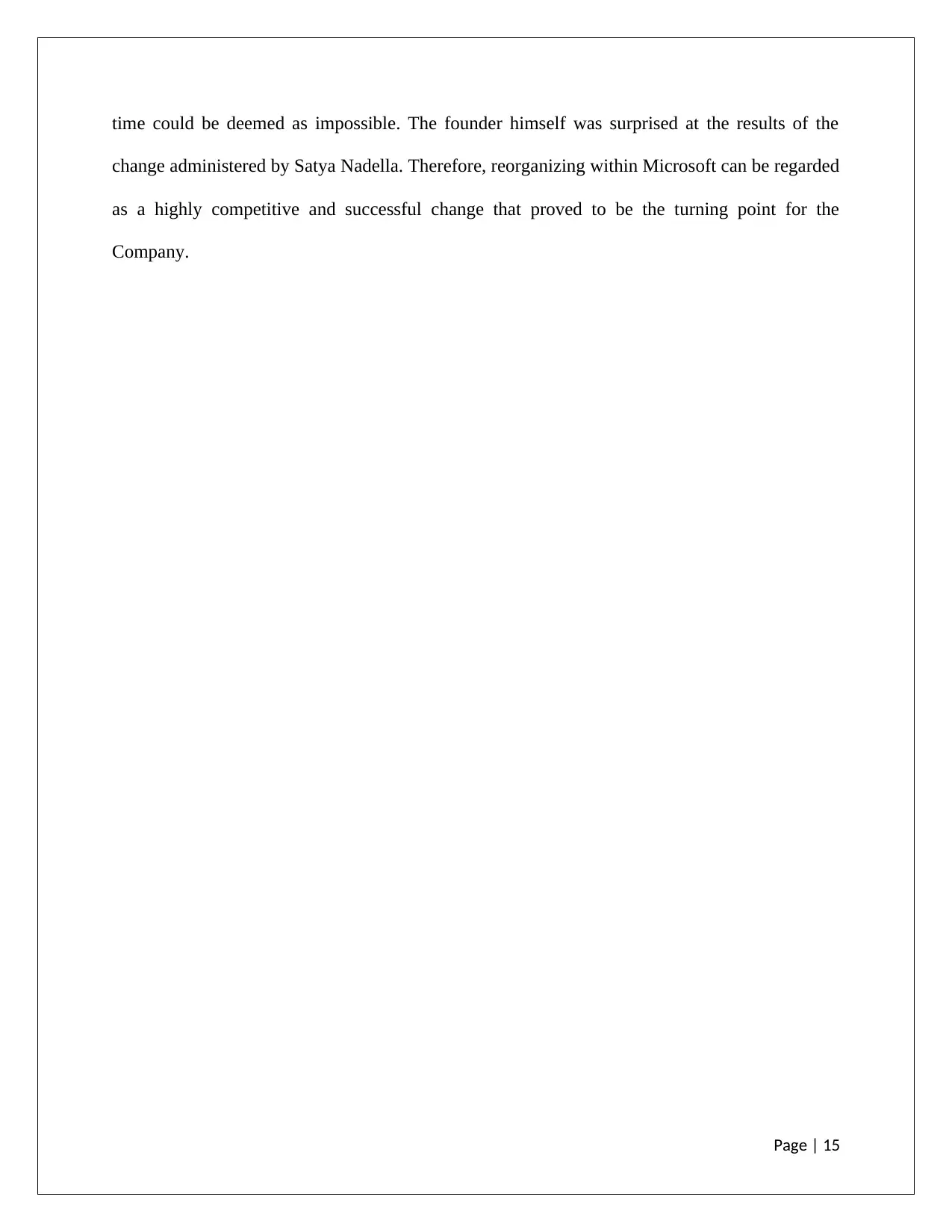
time could be deemed as impossible. The founder himself was surprised at the results of the
change administered by Satya Nadella. Therefore, reorganizing within Microsoft can be regarded
as a highly competitive and successful change that proved to be the turning point for the
Company.
Page | 15
change administered by Satya Nadella. Therefore, reorganizing within Microsoft can be regarded
as a highly competitive and successful change that proved to be the turning point for the
Company.
Page | 15

Reference Lists
Cameron, E. and Green, M., 2015. Making sense of change management: A complete guide to
the models, tools and techniques of organizational change. Kogan Page Publishers.
Doppelt, B., 2017. Leading change toward sustainability: A change-management guide for
business, government and civil society. Routledge.
Easter, T.H. and Brooks, S., 2017. Our leader is gone, now what? Creating the foundation for
stable transitions. People & Strategy, 40(1), pp.28-33.
Galliers, R.D. and Leidner, D.E. eds., 2014. Strategic information management: challenges and
strategies in managing information systems. Routledge.
Hayes, J., 2014. The theory and practice of change management. Palgrave Macmillan.
Hechanova, R.M. and Cementina-Olpoc, R., 2013. Transformational leadership, change
management, and commitment to change: A comparison of academic and business
organizations. The Asia-Pacific Education Researcher, 22(1), pp.11-19.
Klaus, C., 2014. Change Management. Grundlagen und Erfolgsfaktoren.
Merrell, P. and Watson, T., 2012. Effective change management: The simple truth. Management
Services, 56(2), pp.20-23.
Shaw, K. N. (Retrieved on 13th January 2018). Changing the goal-setting.
http://www.csus.edu/indiv/s/sablynskic/documents/changingtthegoalsettingatmicrosoft.pdf.
Troyani, L. (Retrieved on 8th January 2018). 3 EXAMPLES OF ORGANIZATIONAL
CHANGE DONE RIGHT. https://www.tinypulse.com/blog/3-examples-of-organizational-
change-and-why-they-got-it-right.
Van der Voet, J., 2014. The effectiveness and specificity of change management in a public
organization: Transformational leadership and a bureaucratic organizational structure. European
Management Journal, 32(3), pp.373-382.
Page | 16
Cameron, E. and Green, M., 2015. Making sense of change management: A complete guide to
the models, tools and techniques of organizational change. Kogan Page Publishers.
Doppelt, B., 2017. Leading change toward sustainability: A change-management guide for
business, government and civil society. Routledge.
Easter, T.H. and Brooks, S., 2017. Our leader is gone, now what? Creating the foundation for
stable transitions. People & Strategy, 40(1), pp.28-33.
Galliers, R.D. and Leidner, D.E. eds., 2014. Strategic information management: challenges and
strategies in managing information systems. Routledge.
Hayes, J., 2014. The theory and practice of change management. Palgrave Macmillan.
Hechanova, R.M. and Cementina-Olpoc, R., 2013. Transformational leadership, change
management, and commitment to change: A comparison of academic and business
organizations. The Asia-Pacific Education Researcher, 22(1), pp.11-19.
Klaus, C., 2014. Change Management. Grundlagen und Erfolgsfaktoren.
Merrell, P. and Watson, T., 2012. Effective change management: The simple truth. Management
Services, 56(2), pp.20-23.
Shaw, K. N. (Retrieved on 13th January 2018). Changing the goal-setting.
http://www.csus.edu/indiv/s/sablynskic/documents/changingtthegoalsettingatmicrosoft.pdf.
Troyani, L. (Retrieved on 8th January 2018). 3 EXAMPLES OF ORGANIZATIONAL
CHANGE DONE RIGHT. https://www.tinypulse.com/blog/3-examples-of-organizational-
change-and-why-they-got-it-right.
Van der Voet, J., 2014. The effectiveness and specificity of change management in a public
organization: Transformational leadership and a bureaucratic organizational structure. European
Management Journal, 32(3), pp.373-382.
Page | 16
Secure Best Marks with AI Grader
Need help grading? Try our AI Grader for instant feedback on your assignments.
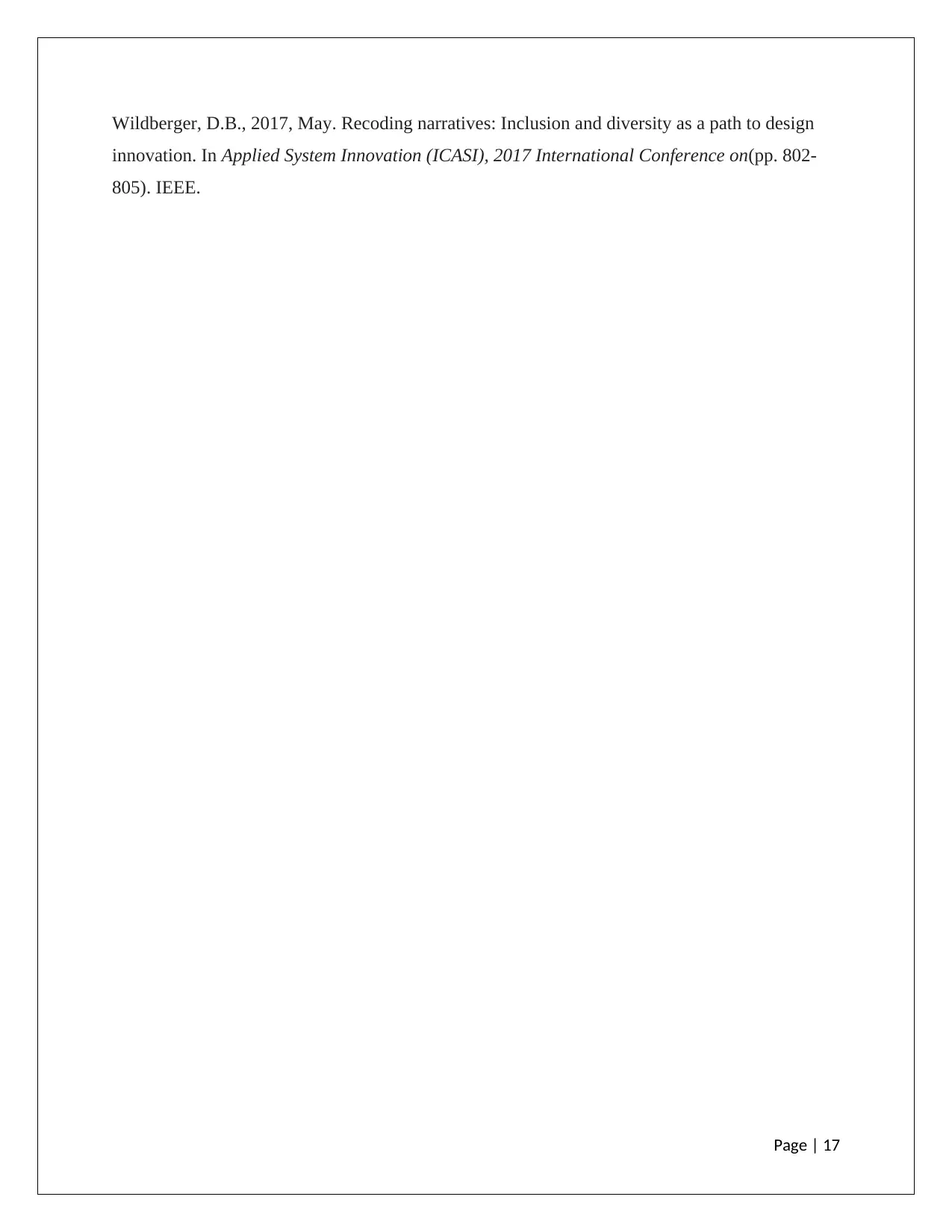
Wildberger, D.B., 2017, May. Recoding narratives: Inclusion and diversity as a path to design
innovation. In Applied System Innovation (ICASI), 2017 International Conference on(pp. 802-
805). IEEE.
Page | 17
innovation. In Applied System Innovation (ICASI), 2017 International Conference on(pp. 802-
805). IEEE.
Page | 17
1 out of 17
Related Documents
Your All-in-One AI-Powered Toolkit for Academic Success.
+13062052269
info@desklib.com
Available 24*7 on WhatsApp / Email
![[object Object]](/_next/static/media/star-bottom.7253800d.svg)
Unlock your academic potential
© 2024 | Zucol Services PVT LTD | All rights reserved.





